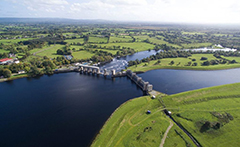The Shannon hydroelectric Scheme was a major development by the Irish Free State in the 1920s to harness the power of the River Shannon. Its product, the Ardnacrusha power plant, is a hydroelectric power station which is still producing power today and is located near Ardnacrusha within County Clare approximately 2.4 kilometres (1.5 mi) from the Limerick border. It is Ireland's largest river hydroelectric scheme and is operated on a purpose built headrace connected to the River Shannon. The plant includes fish ladders so that returning fish, such as salmon, can climb the river safely past the power station.
 Completed within 7 years of Irish independence in 1922 at a cost which was equivalent to one fifth of the Irish state's annual budget, the plant enabled an enormous surge in demand for electricity across the country and demonstrated the ability of the new government to develop during a difficult financial period. The plant was constructed by the German company Siemens-Schuckert, although much of the design was done by Irish engineers and Ireland provided most of the labour force. The scheme involved changes to the flow of the whole river, multiple dams and bridges and the construction of a national power grid.
Completed within 7 years of Irish independence in 1922 at a cost which was equivalent to one fifth of the Irish state's annual budget, the plant enabled an enormous surge in demand for electricity across the country and demonstrated the ability of the new government to develop during a difficult financial period. The plant was constructed by the German company Siemens-Schuckert, although much of the design was done by Irish engineers and Ireland provided most of the labour force. The scheme involved changes to the flow of the whole river, multiple dams and bridges and the construction of a national power grid.
The generating plant at Ardnacrusha is composed of three vertical-shaft Francis turbine generators (commissioned in 1929) and one vertical-shaft Kaplan turbine generator (commissioned in 1934) operating under an average head of 28.5 metres. The scheme originally was designed for six turbines, with four turbines fitted. The 85 MW of generating plant in Ardnacrusha was adequate to meet the electricity demand of the entire country in the early years. The full output equates to about 332,000 MWh generated on an annual basis. Ardnacrusha generates at 10.5 kilovolts (kV) but this is transformed to 38 kV for local distribution and to 110 kV for long distance transmission. More details
 Completed within 7 years of Irish independence in 1922 at a cost which was equivalent to one fifth of the Irish state's annual budget, the plant enabled an enormous surge in demand for electricity across the country and demonstrated the ability of the new government to develop during a difficult financial period. The plant was constructed by the German company Siemens-Schuckert, although much of the design was done by Irish engineers and Ireland provided most of the labour force. The scheme involved changes to the flow of the whole river, multiple dams and bridges and the construction of a national power grid.
Completed within 7 years of Irish independence in 1922 at a cost which was equivalent to one fifth of the Irish state's annual budget, the plant enabled an enormous surge in demand for electricity across the country and demonstrated the ability of the new government to develop during a difficult financial period. The plant was constructed by the German company Siemens-Schuckert, although much of the design was done by Irish engineers and Ireland provided most of the labour force. The scheme involved changes to the flow of the whole river, multiple dams and bridges and the construction of a national power grid.The generating plant at Ardnacrusha is composed of three vertical-shaft Francis turbine generators (commissioned in 1929) and one vertical-shaft Kaplan turbine generator (commissioned in 1934) operating under an average head of 28.5 metres. The scheme originally was designed for six turbines, with four turbines fitted. The 85 MW of generating plant in Ardnacrusha was adequate to meet the electricity demand of the entire country in the early years. The full output equates to about 332,000 MWh generated on an annual basis. Ardnacrusha generates at 10.5 kilovolts (kV) but this is transformed to 38 kV for local distribution and to 110 kV for long distance transmission. More details